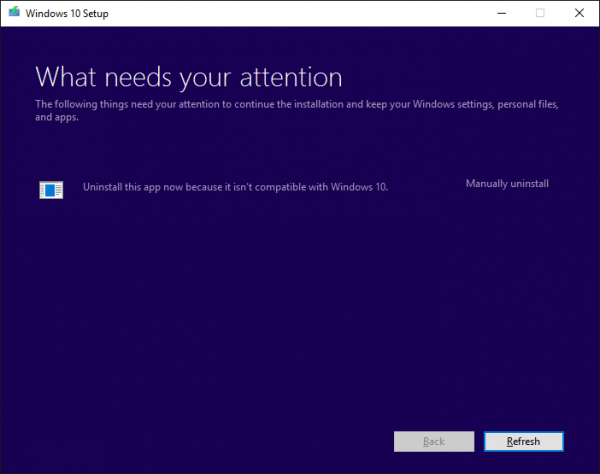Many a time Windows 111 or Windows 10 Updates get stuck. The update downloads just fine, but when the system goes ahead to update further, an error like incompatible applications, blocking applications, and the Error code 0xc1900208 shows up. All this keeps happening because few applications block the update process.
What do you do when Windows Setup throws you a message – Uninstall this app now because it isn’t compatible with Windows 11/10? It may be accompanied by Error Code 0xc1900208. If it is installed, you may select the Manually uninstall option. But sometimes, the applications are not even installed, but they have traces in the form of associations. This process lets you identify & remove those associations. You may see this message for apps like VirtualBox, VMware, etc,
In this post, we will discuss how to remove blocking applications that prevent the Windows 11/10 Update from completing.
Uninstall this app now because it isn’t compatible with Windows 11/10

Steps to remove blocking applications
The reason Windows Upgrade fails, is because of apps that are not compatible with the next version of Windows. Chances are that they would work, but they haven’t passed through the compatibility check. When you run Windows 10 Upgrade Advisor, the system checks for such apps and warns you. The same happens during every upgrade.
While it should not block, things don’t always go straight. Many times, the app may not be installed on your PC, but it is likely that the compatibility checker is detecting a file associated with the app rather than the app itself.
You must delete the file it is detecting before you can install the upgrade. You can determine which file triggers the block by examining a hidden log file.
To do this, follow these steps:
- Open File Explorer and click the View tab. Make sure to select the checkbox for Hidden items.
- Select This PC, and type *_APPRAISER_HumanReadable.xml in the search box and search the PC for filenames that end with this term.
- Right-click the file that ends with _APPRAISER_HumanReadable.xml and opens the file with Notepad.
- Press CTRL + F and search for DT_ANY_FMC_BlockingApplication. Look for the value, it should be True.
- Press CTRL + F and search for LowerCaseLongPathUnexpanded. The value contains the file path of the program. You should remove or transfer to another drive. (It should be located approximately 28 lines under the DT_ANY_FMC_BlockingApplication).
- Make note of the file path listed in the value for LowerCaseLongPathUnexpanded. You can select the file path and copy it to the Notepad by pressing CTRL + C.
- Navigate to the file path’s location in File Explorer. (Click on File Explorer’s address bar and press CTRL + V to paste the file path you copied earlier.)
- Once you’ve located the blocking.exe file, transfer the file to another drive or Delete the file.
PowerShell Script to fix remove blocking applications
If you find the above step difficult, you can download this PowerScript file from Microsoft, and run it when you face this blocking application error. A zip file with the name AppRPS.zip will download on your computer.
Once you had unzipped the script file, run it with Administrator privilege. Once the blocking file is moved or deleted, try installing the Windows upgrade again, or return to the Windows Upgrade Assistant and select the Refresh button.
I hope this helps!